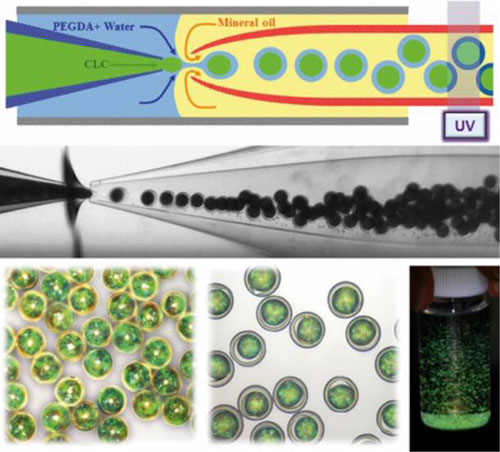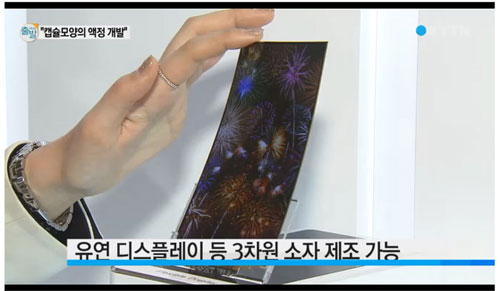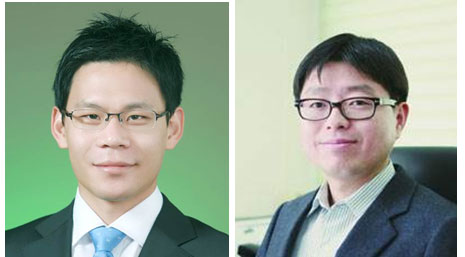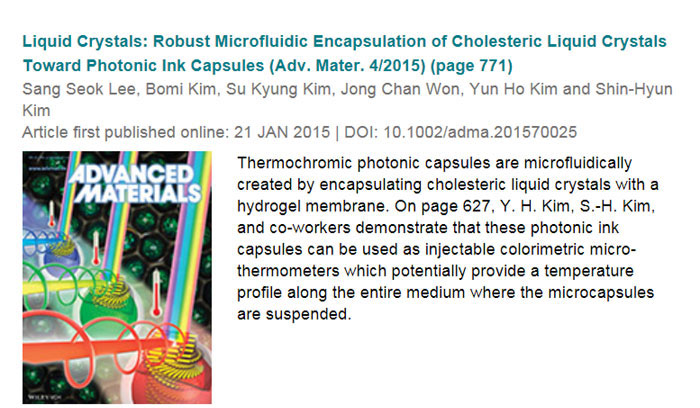Liquid crystal displays (LCDs) have been widely used for TV and laptop screens, among others, as they can show an image's color and shape quite clearly. However, a weakness is that the image on an LCD screen changes when seen from the side, not from the front, due to LCD's flowing nature, like a liquid.
A team of scientists has recently come up with a solution to this. The team, led by Kim Yun Ho, a senior researcher at the Korea Research Institute of Chemical Technology (KRICT), and by Kim Shin Hyun, a professor at the Korea Advanced Institute of Science & Technology (KAIST), has developed a new "encapsulated" form of LCD production.
The newly developed technology uses cholesteric liquid crystals, which have a spiral molecule arrangement and unique reflection characteristics. This technology encapsulates the material in an equally small size within a thin layer.
Using microfluidics made from glass capillaries, the research team encapsulated the liquid crystals with water. The encapsulated liquid crystals are stable in the air, and show unchanged optical characteristics when seen from all directions. It is also highly resistant to external changes, like pressure or bending, and shows images unchanged from all sides, presenting a key to solving the main weakness of existing LCDs.


Thanks to the new technology, LCDs, which used to be used for only two-dimensional structures, can now be used in a new way as 3-D elements for flexible displays, micro laser or 3-D printer inks, said the research team. As the encapsulated liquid crystals show changes of color according to temperature, they can be used to sense the ambient temperature or can be used as a smart window technology which can change color.
“By using this technology, liquid crystals which have nature-like flowing characteristics can be made into round or 3-D shapes. In the future, this will play a huge role in the development of the optical sciences industry,” said Kim Yun Ho of the KRICT.

This research was sponsored through a support project for leading researchers by the KRICT and the National Research Foundation of Korea in order to incubate engines of future economic growth. The research results were published online on January 27 in Advanced Materials, an international journal.

By Yoon Sojung
Korea.net Staff Writer
Photos: The Korea Research Institute of Chemical Technology
arete@korea.kr
A team of scientists has recently come up with a solution to this. The team, led by Kim Yun Ho, a senior researcher at the Korea Research Institute of Chemical Technology (KRICT), and by Kim Shin Hyun, a professor at the Korea Advanced Institute of Science & Technology (KAIST), has developed a new "encapsulated" form of LCD production.
The newly developed technology uses cholesteric liquid crystals, which have a spiral molecule arrangement and unique reflection characteristics. This technology encapsulates the material in an equally small size within a thin layer.
Using microfluidics made from glass capillaries, the research team encapsulated the liquid crystals with water. The encapsulated liquid crystals are stable in the air, and show unchanged optical characteristics when seen from all directions. It is also highly resistant to external changes, like pressure or bending, and shows images unchanged from all sides, presenting a key to solving the main weakness of existing LCDs.

The above images show how to make encapsulated micro liquid crystals and their optical characteristics.

When bent or pressed, the newly developed liquid crystals still show the same image. (captured from YTN)
Thanks to the new technology, LCDs, which used to be used for only two-dimensional structures, can now be used in a new way as 3-D elements for flexible displays, micro laser or 3-D printer inks, said the research team. As the encapsulated liquid crystals show changes of color according to temperature, they can be used to sense the ambient temperature or can be used as a smart window technology which can change color.
“By using this technology, liquid crystals which have nature-like flowing characteristics can be made into round or 3-D shapes. In the future, this will play a huge role in the development of the optical sciences industry,” said Kim Yun Ho of the KRICT.

Kim Yun Ho of the KRICT (left) and Kim Shin Hyun of KAIST led the research team.
This research was sponsored through a support project for leading researchers by the KRICT and the National Research Foundation of Korea in order to incubate engines of future economic growth. The research results were published online on January 27 in Advanced Materials, an international journal.

The cover of Advanced Materials, dated January 27, 2015.
By Yoon Sojung
Korea.net Staff Writer
Photos: The Korea Research Institute of Chemical Technology
arete@korea.kr
Most popular
- Korea.net welcomes 2025 K-influencers, Honorary Reporters
- 2025 Honorary Reporter class pledges to spread 'real Korea' worldwide
- US urged to exempt tariffs on Korea in first '2+2' trade talks
- Korean culture festival in Cuba marks 1st year of bilateral ties
- Slew of festivals, events scheduled in downtown Seoul in May
